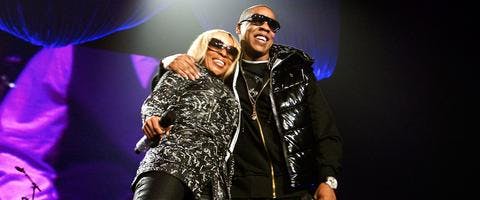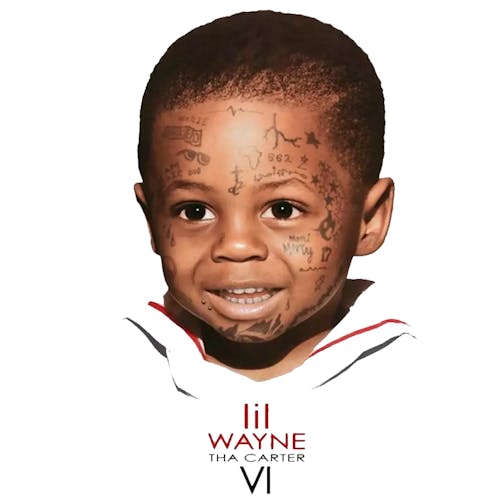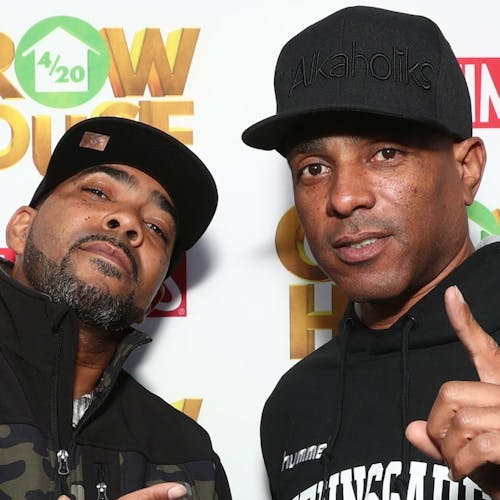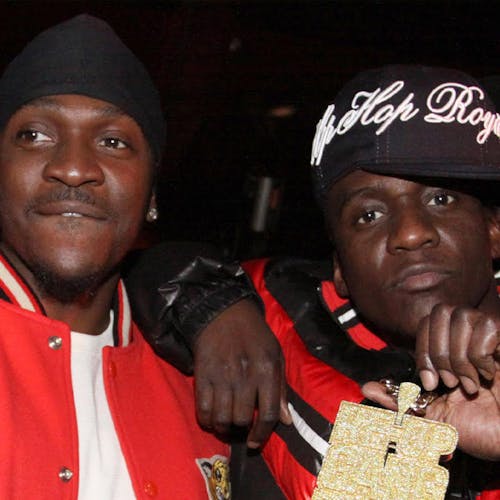
From Dapper To Dope: Hip-Hop's Influence On R&B
From Dapper To Dope: Hip-Hop's Influence On R&B
Published Tue, August 25, 2020 at 1:16 PM EDT
As the 1980s gave way to the 1990s, Andre Harrell's Uptown Records was the major catalyst for the melding of Hip-Hop and R&B.
The fusion of the two genres had tentative beginnings. In 1985, Kurtis Blow appeared on René & Angela’s “Save Your Love (for No. 1)” and Melle Mel guested on Chaka Khan’s hit “I Feel for You” (in which Khan famously hated the scratching and rapping). But things evolved more organically a few years later, as Teddy Riley kickstarted the new jack swing era by melding R&B smoothness to Hip-Hop production. The pairings were becoming more harmonious; LeVert had Heavy D appear on “Just Coolin’,” Janet Jackson also employed the Overweight Lover’s talents on her hit “Alright,” and Jody Watley famously recruited Eric B. & Rakim for “Friends” in 1989.
"At first [MCA] shot it down," Jody recalled to Michael Shulman in 2013. "'No.' But, being the kind of person I am, I stayed on them. 'It’ll be great!' Then, once MCA came around to the concept, they wanted me to do it with the Fresh Prince — Will Smith."
"And I said 'No,' because, to me, it wasn’t as interesting. And while he was popular, and on the Pop chart; Eric B. & Rakim just had that street sensibility, and I loved Rakim’s voice so much, and they were so important in the Hip-Hop movement (not that Will Smith wasn’t, in his way). So, my desire to work with Eric B. & Rakim was really organic, because I was such a fan of theirs. Eventually MCA came around, and they let us get on with it. Luckily, Eric B. & Rakim were into the idea – and Rakim was awesome. He just wanted to complement with his rap verses what I had written for the verses I sang – and we worked great, together. The rest is just history."
Bobby Brown’s Don’t Be Cruel was an R&B blockbuster that made the former New Edition bad boy a star with pop audiences. His brashness and penchant for offhand rhyming cemented his position at the forefront of Hip-Hop and R&B’s fusion. N.E. had always been somewhat tied to their Hip-Hop roots from Roxbury, Massachusetts. They breakdanced in the early video “She Gives Me a Bang” and lead singer Ralph Tresvant famously rapped his bandmates' names in their breakthrough hit “Cool It Now.” But it was during that new jack swing-driven period that R&B seemed to fully warm up to Hip-Hop in terms of production and collaboration with rappers. And in 1990, an unlikely trio pushed that approach forward.
It was Brown’s former N.E. bandmates Ricky Bell, Mike Bivins, and Ronnie DeVoe (Bell Biv DeVoe) who moved R&B squarely into Hip-Hop’s sonic, cultural, and visual orbit. They presented themselves with the roguish swagger of rap stars independent of N.E.’s dapper roots, steering the early 1990s into decidedly edgier territory. Bell Biv DeVoe called this approach “mental.” Though their popularity lasted a brief time, the trio’s impact was seismic across urban music and the pop world.
“The kind of style we were groomed into from our early days had this Temptations, Jacksons, Blue Magic kind of feel. That was what caught us, that whole kind of flavor,” Bell explained to the Baltimore Sun in 1990. But when the trio of Bell, Bivins and DeVoe decided to form a spinoff group, they went for something harder in sound and tougher in image. It made for a groundbreaking fusion of Hip-Hop presentation and R&B slickness.
DROP YOUR EMAIL
TO STAY IN THE KNOW

"At first [MCA] shot it down. 'No.' But, being the kind of person I am, I stayed on them. 'It’ll be great!' Then, once MCA came around to the concept, they wanted me to do it with the Fresh Prince — Will Smith."
- Jody Watley on the making of "Friends" with Eric B. & Rakim
“We wanted that Hip-Hop flavor, but we wanted to kind of smooth it out," said Bell. "We figured we’d put some harmonies, some melodies over [it] and that would kind of smooth the whole thing out.”
Uptown Records was enjoying early success with new jack crooner Christopher Williams and the ever-present Heavy D. But it was with rapper Father MC that the seeds were sown for the company’s forward leap.
Two up-and-coming acts — a singer named Mary J. Blige and a quartet out of North Carolina called Jodeci — were tapped to appear on Father MC’s early singles. Harrell’s approach with those artists was indicative of the label’s trajectory.
“When I met Andre, I thought, ‘This is a guy who could have been doing this 50 years ago,’ ” commented famed entertainment attorney Nina Shaw in 1993. “He took talent and molded it like the guys in the early days of Hollywood. They were in the glove business and went and made movies. Andre started with music and now he’s doing TV and movies in his own way. He’s the same kind of force, and you don’t find that spirit much anymore.”
Harrell aimed to blend Hip-Hop and R&B in a more organic and soulful way than the dance-floor approach that defined the era of new jack swing. With the Uptown sound, acts like Blige and Jodeci pushed mainstream R&B into new territory (famously dubbed “Hip-Hop soul”) and completed R&B’s embrace of Hip-Hop swagger and sounds. Jodeci’s “Come & Talk to Me” remix was a harbinger of things to come: The single was a departure from the Al B. Sure! new jack sound of Jodeci’s debut album, Forever My Lady. Within a few months of that release, Blige dropped her debut What’s the 411?, with one foot in the new jack that preceded it and the other in the future of urban music.
“I think she’s always been the blueprint for the whole ghetto-fabulous movement,” Harrell said in 1997. Blige’s albums and singles prominently featured rappers that weren’t of the pop-rap variety: Busta Rhymes, Craig Mack, Keith Murray, Grand Puba, and The Notorious B.I.G. all made appearances on her early projects, forever connecting her to Hip-Hop in a way that seemed honest and fresh when compared to her predecessors.

When I met Andre [Harrell], I thought, ‘This is a guy who could have been doing this 50 years ago...' ”
- Nina Shaw, Entertainment Attorney
The approach realigned R&B in the 1990s. The sophisticated, urbane manner of ’80s stars like Luther Vandross, Whitney Houston, and Anita Baker didn’t disappear entirely, however.
It was present in ’90s urban contemporary stars like Toni Braxton and Brian McKnight. But it wasn’t the singular approach to R&B stardom anymore: women were rocking jerseys and combat boots, and men were singing shirtless. It was a new age and Hip-Hop’s influence had taken over the genre.
And the cross-genre pairings were becoming less novel and more inspired. Hip-Hop and R&B were no longer wary of each other at all, and pop stars got in on the act. Mariah Carey would feature Ol' Dirty Bastard on her 1995 smash "Fantasy" remix; the first of what would become a long-standing series of rap-assisted hits for the megastar.
Janet's early collaboration with Heavy D was an indicator of her long-term approach; she would take rapper collaborations quite seriously throughout her career. The diva would feature Hip-Hop stars on many of her biggest hits; MC Lyte guested on "You Want This" in 1994, Q-Tip was prominently featured on 1997s "Got Til It's Gone;" and Missy Elliott provided a verse and ad-libs on 2001s "Son of A Gun."
In addition to her tracks with Chuck D, Nelly and so many others, Janet embraced Hip-Hop as an inspiration. 1989s Rhythm Nation 1814 seemed to bear the influence of Public Enemy's bombastic sound.
And her 1993 janet. album saw the singer adopt an "around the way girl" image that coincided with her starring alongside rapper/actor Tupac Shakur in John Singleton's Poetic Justice. Hip-Hop had become a core tenet of Black popular culture, it was shaping the image and sound of everything.
By 1994, even teen R&B stars had to present themselves with substantial edge.
There was more of a Hip-Hop flair to how adolescent singers presented themselves by the mid-1990s. Just a couple of years prior, pubescent singers like Tevin Campbell, Hi-Five, and Shanice were enjoying platinum success on the strength of hit singles with innocent titles like “I Like the Way (The Kissing Game),” “I Love Your Smile,” and “Can We Talk?”
But in the post-Uptown landscape, young R&B acts were presenting in a more adult fashion, notably Aaliyah’s controversial “Age Ain’t Nothing but a Number” and Usher’s innuendo-laden early single “Can U Get Wit It.” Brandy was the more mall-friendly icon of this particular wave, but even she recorded songs with rappers like MC Lyte and Ma$e. In many ways, spin-the-bottle R&B was dead.
Aaliyah and Usher, in particular, would have long-standing influence over R&B and Hip-Hop into the early 2000s, but in the mid-1990s, it was Brandy who had the highest visibility and biggest commercial success amongst R&B's young stars.
Yo-Yo, Queen Latifah and Lyte famously guested on Brandy's "I Wanna Be Down" remix, another high profile smash that prominently featured Hip-Hop and R&B organically intertwined in a way that felt wholly natural.
As Harrell moved from Uptown to Motown in 1993 and focused on television and film production, Heavy D took the helm at Uptown and furthered the R&B/Hip-Hop fusion. Heavy-produced acts like Soul IV Real and Monifah fortified the label's sound as it transitioned out of new jack swing towards the Hip-Hop soul era it'd help initiate.
And with Harrell moving on, an impresario that he helped mentor was taking the Uptown formula to a new label. It’s well-known that Sean “Puffy” Combs was Harrell’s protégé at Uptown, and it was Combs who helped develop acts like Father MC, Blige, and Jodeci by combining Hip-Hop and R&B in a way that made for multiplatinum hits.
At Bad Boy Records, Combs amplified that approach: pairing hardcore Brooklyn rhymer The Notorious B.I.G. with R&B-friendly production got him played in places most rappers of his ilk had never ventured. And it was Combs who shepherded the careers of Bad Boys’ R&B stable: acts like Faith Evans, 112, and Carl Thomas, artists who, per the Blige tradition, were as steeped in Hip-Hop as they were in R&B. The resulting success of his label and approach meant that R&B was embracing Hip-Hop. And Hip-Hop was now embracing R&B. To be a hardcore rapper no longer meant eschewing romantic themes or the use of a singer crooning the chorus on a single. It led to Hip-Hop finally breaking through on radio stations across America that were still reluctant — even as late as the mid-1990s — to embrace rap music.
"Neo-soul" was a burgeoning movement that tethered itself to the classic soul singer-songwriters of the 1970s (a la Stevie Wonder and Minnie Riperton) while also highlighting the wide-ranging jazz-rap influences of acts like A Tribe Called Quest. By the late 1990s, artists like D'Angelo, Erykah Badu and Lauryn Hill were demonstrating how organically boho-rap stylings and the earthy sensibilities of this wave of soul artists interconnected. Legendary producer J. Dilla was a lynchpin for artists like The Roots, Common and Raphael Saadiq; and as part of the Soulquarians collective, helped to blur the lines between such acts.
The songwriting/production of Timbaland and Missy Elliott further melded Hip-Hop and R&B with their hitmaking Superfriends collective, which included rapper Magoo, R&B heartthrob Ginuwine and established superstar Aaliyah. Elliott's own music featured her rapping and singing in equal measure, and her list of collaborators included virtually everyone popular in urban music; from Lil Kim and Ludacris to 702 and SWV. Aaliyah would become one of the biggest stars of the late 90s on the success of Tim and Missy's production, but also her own fruitful pairings with Hip-Hop stars like Elliott, Nas and DMX.
But there was no greater ambassador for, and example of, the merging of Hip-Hop and R&B than Mary J. Blige. Her run of albums and hits like "You're All I Need (I'll Be There For You)" with Method Man made her the face of R&B's new generation, and there's still no one who embodies the hybrid nature of the past 30 years of Black music. Her "Queen Of Hip-Hop Soul" moniker has always been appropriate because she's always embodied Hip-Hop's spirit in a soul context.
"I like the name," she told Paul Freeman in a 1997 regarding her famous nickname. "I've worked real hard to get it. Now I've got to work hard to keep it. Even if you don't have a crown, you've got to work hard to keep anything you have. And you're always working to get to the next level. When people get into the business, they have to look at it as not all glamour but as real hard work.”

By the 2000s, the bridging of both genres felt like a natural fit for an entire generation. Singers like Usher, Chris Brown, Omarion, Kelis, Pretty Ricky, and many others over the past 20 years have sat at both tables, to the point in which the term “urban” has become a musical catch-all for artists who have both audiences. Now those two audiences are almost one and the same because of ground that was broken 30 years ago.
The loss of Andre Harrell is tremendous. This was the man who, like rock and roll spokespersons Dick Clark and Alan Freed, saw the value of taking a lesser-known type of music and popularizing it for mainstream listeners. To his credit, he didn’t dilute R&B to make it pop-friendly, as had been the approach through the 1980s. Instead, he made R&B more street. In doing so, he reconnected R&B to a tradition that included legends like Curtis Mayfield and Bobby Womack, while also paving the way for a future in which Beyoncé could rap and Andre 3000 could sing. Hip-Hop and R&B, in the contemporary sense, are two sides of the same coin. For that, we can thank Andre Harrell.



